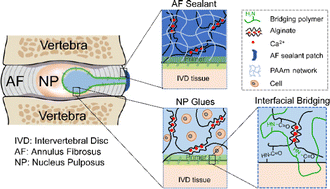Tissue-mimetic hybrid bioadhesives for intervertebral disc repair†
Abstract
Intervertebral disc (IVD) degeneration and herniation often necessitate surgical interventions including a discectomy with or without a nucleotomy, which results in a loss of the normal nucleus pulposus (NP) and a defect in the annulus fibrosus (AF). Due to the limited regenerative capacity of the IVD tissue, the annular tear may remain a persistent defect and result in recurrent herniation post-surgery. Bioadhesives are promising alternatives but show limited adhesion performance, low regenerative capacity, and inability to prevent re-herniation. Here, we report hybrid bioadhesives that combine an injectable glue and a tough sealant to simultaneously repair and regenerate IVD post-nucleotomy. The glue fills the NP cavity while the sealant seals the AF defect. Strong adhesion occurs with the IVD tissues and survives extreme disc loading. Furthermore, the glue can match native NP mechanically, and support the viability and matrix deposition of encapsulated cells, serving as a suitable cell delivery vehicle to promote NP regeneration. Besides, biomechanical tests with bovine IVD motion segments demonstrate the capacity of the hybrid bioadhesives to restore the biomechanics of bovine discs under cyclic loading and to prevent permanent herniation under extreme loading. This work highlights the synergy of bioadhesive and tissue-engineering approaches. Future works are expected to further improve the tissue specificity of bioadhesives and prove their efficacy for tissue repair and regeneration.

- This article is part of the themed collection: Materials Horizons 10th anniversary regional spotlight collection: The Americas


 Please wait while we load your content...
Please wait while we load your content...